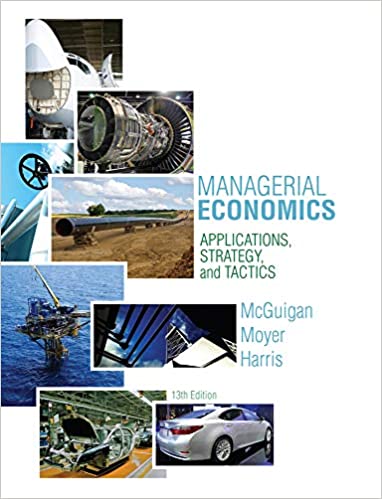
Managerial Economics 13th Edition by James McGuigan,Charles Moyer,Frederick Harris
Edition 13ISBN: 978-1285420929
Managerial Economics 13th Edition by James McGuigan,Charles Moyer,Frederick Harris
Edition 13ISBN: 978-1285420929 Exercise 6
A product manager has been reviewing selling expenses (i.e., advertising, sales commissions, etc.) associated with marketing a line of household cleaning products. The manager suspects that there may be some sort of diminishing marginal returns relationship between selling expenses and the resulting sales generated by these expenditures. After examining the selling expense and sales data for various regions (all regions are similar in sales potential) shown in the following table, however, the manager is uncertain about the nature of the relationship.

a. Using the linear regression model
Y = + X
where Y is sales and X is selling expenses, estimate , , and the r2 statistic by the least-squares technique.
b. Using the exponential function model
Y = X
apply the double-logarithmic transformation to obtain a linear relationship that can be estimated by the least-squares technique.
c. Applying the least-squares technique, estimate , , and the r2 statistic for the transformed (linear) model in part (b). (Note that the logarithms of the X and Y variables needed in the calculations are given in the table.)
d. Based on the r2 statistics calculated in parts (a) and (c), which model appears to give a better fit of the data
e. What implications does the result in part (d) have for the possible existence of a diminishing marginal returns relationship between sales and selling expenses as suggested by the manager
f. What other transformations of the variables might we try to give a better fit to the data

a. Using the linear regression model
Y = + X
where Y is sales and X is selling expenses, estimate , , and the r2 statistic by the least-squares technique.
b. Using the exponential function model
Y = X
apply the double-logarithmic transformation to obtain a linear relationship that can be estimated by the least-squares technique.
c. Applying the least-squares technique, estimate , , and the r2 statistic for the transformed (linear) model in part (b). (Note that the logarithms of the X and Y variables needed in the calculations are given in the table.)
d. Based on the r2 statistics calculated in parts (a) and (c), which model appears to give a better fit of the data
e. What implications does the result in part (d) have for the possible existence of a diminishing marginal returns relationship between sales and selling expenses as suggested by the manager
f. What other transformations of the variables might we try to give a better fit to the data
Explanation
a)
Linear Regression model is given as f...
Managerial Economics 13th Edition by James McGuigan,Charles Moyer,Frederick Harris
Why don’t you like this exercise?
Other Minimum 8 character and maximum 255 character
Character 255


